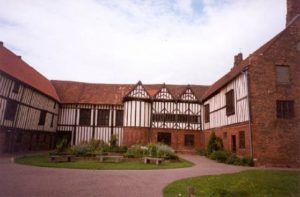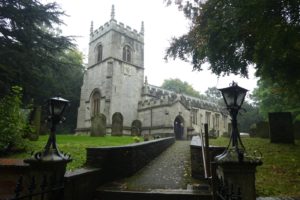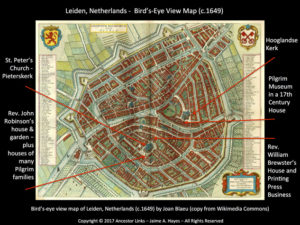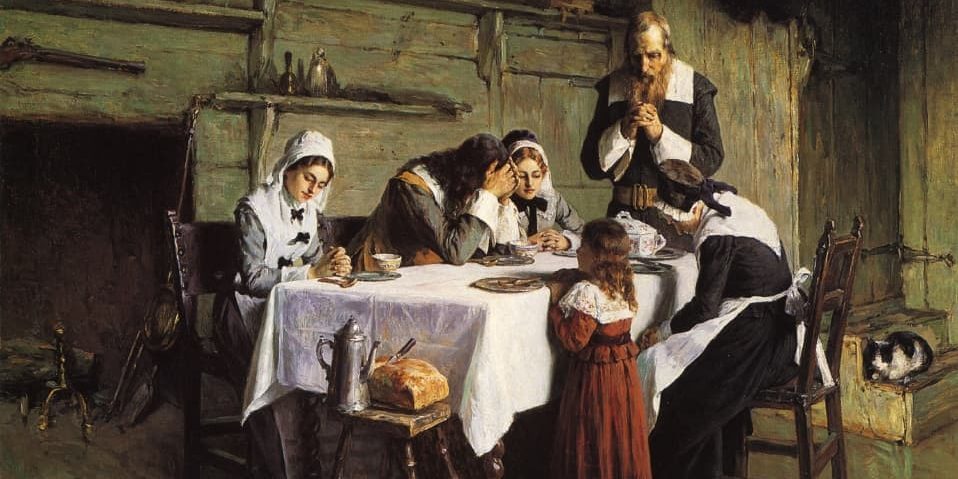The Pilgrim or Separatist church began in the home but focused on the exaltation and presence of Christ. The revival of “hearth and home” in England was nurtured by families who had access to own the Geneva translation of the Bible in their own tongue. Fathers would read from the Scriptures in the morning and expound its truth, coupled with leading their families in prayer and the singing of psalms. With King James as the head of the church and parish attendance mandatory, it soon became dangerous to conduct church at home, but the presence of Christ was worth the risk.
William Bradford, Pilgrim historian, wrote that
“the one side labored to have the right worship of God and discipline of Christ established in the church, according to the simplicity of the gospel, without the mixture of men’s inventions; and to have and to be ruled by the laws of God’s Word, dispensed in those offices… according to the Scriptures. The other party… courts, canons and ceremonies, together with all such livings, revenues and subordinate officers, with other such means as formerly upheld their antichristian greatness and enabled them with lordly and tyrannous power to persecute the poor servants of God.”
For more than two decades, built on the foundation that “where two or three are gathered Christ is present” (from Matthew 18:20), Pastor John Robinson, William Brewster and others would search the Scriptures for the best order or worship “free from men’s inventions.”
As more and more families removed themselves from worshiping in the state church, they began to form “underground” secret gatherings. For a time, a remnant of these believers met at Gainsborough Hall at the great peril of William Hickman and his mother Rose who owned it since 1596 but were secret “puritans.” To meet in secret, or “underground” meant potential arrest, jail, and even death.
 Richard Clyfton, vicar of All Saints’ Church in Babworth since 1586, began holding services for Separatists and was thus “illegal” in the eyes of the Bishopric. Here it was that a young teen named William Bradford was converted after walking several miles from his home to church at 12 years of age (in 1602) and a young John Robinson became assistant to Clyfton by 1605.
Richard Clyfton, vicar of All Saints’ Church in Babworth since 1586, began holding services for Separatists and was thus “illegal” in the eyes of the Bishopric. Here it was that a young teen named William Bradford was converted after walking several miles from his home to church at 12 years of age (in 1602) and a young John Robinson became assistant to Clyfton by 1605.
Studying the Scriptures further, they separated and formed a church by voluntary covenant in 1606 at Scrooby Manor to the great danger of William Brewster, who served as postmaster to the Queen in this Manor House. In contrast with the State Church, it was “church by covenant.” Bradford wrote “they shook off this yoke of antichristian bondage, and as the Lord’s free people joined themselves (by a covenant of the Lord) into a church estate, in the fellowship of the gospel.” Meeting in secret meant praying from the heart, singing psalms and expounding the Bible so that one could obey God more consistently.
 Bradford wrote “Yet seeing themselves thus molested, and that there was no hope of their continuance there, by a joint consent they resolved to go into the Low Countries, where they heard was freedom of religion for all men.” After being put in jail in 1607 for attempting to escape England, the men got to Amsterdam and joined the women and children (who had been betrayed and captured) coming several months later. After a year in Amsterdam, Robinson, Brewster and other leaders, along with the consent of the congregation, left to go to Leiden in order to avoid the disputes and turmoil of the churches. Often persecution serves as a cheap form of unity due to its pressure, but without a heart felt covenant from within, once that is no longer present, people return to self-indulgent forms of religion.
Bradford wrote “Yet seeing themselves thus molested, and that there was no hope of their continuance there, by a joint consent they resolved to go into the Low Countries, where they heard was freedom of religion for all men.” After being put in jail in 1607 for attempting to escape England, the men got to Amsterdam and joined the women and children (who had been betrayed and captured) coming several months later. After a year in Amsterdam, Robinson, Brewster and other leaders, along with the consent of the congregation, left to go to Leiden in order to avoid the disputes and turmoil of the churches. Often persecution serves as a cheap form of unity due to its pressure, but without a heart felt covenant from within, once that is no longer present, people return to self-indulgent forms of religion.
Growing to a congregation of over 300, they successfully practiced church unity and as Bradford wrote “…came as near the primitive pattern of the first churches as any other church of these later times have done, according to their rank and quality.” They positively influenced the Dutch culture with their work ethic for “though many of them were poor, yet there was none so poor but if they were known to be of that congregation the Dutch (either bakers or others), would trust them in any reasonable matter when they wanted money, because they had found by experience how careful they were to keep their word, saw them so painful and diligent in their callings.”
 They were restricted from conducting church in chapels or sanctuaries and initially worshiped in homes. In early 1611, Robinson and other leaders purchased an estate in the Kloksteeg or Bell Lane. The house called “Green Door” or Groenepoort was centrally located and close to St. Peter’s Church with a half acre of land. Records show that 21 houses were built in the open lot. It immediately gave them room to worship together as well as the ability to build homes for their elderly and other families without being a burden upon the Dutch. It was in May of 1612 that Robinson moved into his estate and work began on building in the open lot. It was on May 6, 1612 that the first service in one place allowed Robinson to develop a distinct order of worship focused on the simplicity of the gospel where Christ is present in the assembly. Consider their order of worship:
They were restricted from conducting church in chapels or sanctuaries and initially worshiped in homes. In early 1611, Robinson and other leaders purchased an estate in the Kloksteeg or Bell Lane. The house called “Green Door” or Groenepoort was centrally located and close to St. Peter’s Church with a half acre of land. Records show that 21 houses were built in the open lot. It immediately gave them room to worship together as well as the ability to build homes for their elderly and other families without being a burden upon the Dutch. It was in May of 1612 that Robinson moved into his estate and work began on building in the open lot. It was on May 6, 1612 that the first service in one place allowed Robinson to develop a distinct order of worship focused on the simplicity of the gospel where Christ is present in the assembly. Consider their order of worship:
- Prayer and giving thanks by the Pastor or Teacher.
- Reading of two or three chapters of the Bible, with brief Explanation of the same, as the time may serve.
- The singing of some of the Psalmes of David.
- A sermon – that is, the pastor or teacher expounds and enforces some passage of the Scripture.
- The singing againe of some of the Psalmes of David.
- The sacraments are administered, – that is, the Lord’s Supper on stated Lord’s Days, and baptism whenever there might be a candidate.
- Collection is then made, as each one is able, for the support of the officers, and the poor.
It is this original three-hour worship order, drawn from the Scriptures by the Pilgrims and others, whose goal was to cultivate the presence of Christ rather than focus on the “service” or program. The two-hour sermon modeled applying the Bible to every area of life and articulated ideas of self-rule and voluntary covenant, among others.







